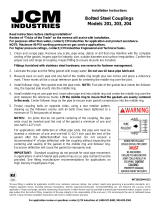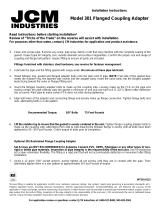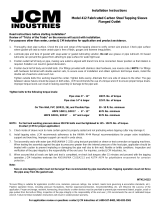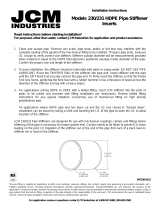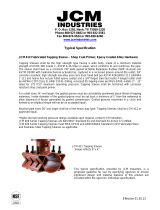Page is loading ...

Read instructions before starting installation*
Review of “Tricks of the Trade” on the reverse will assist with installation.
For purposes other than water, contact JCM Industries for application and product assistance.
1. Clean/remove all dirt, rust, mud or loose scale. Inspect the pipe ends where gaskets contact the pipe for any gouges,
grooves, irregularities or imperfections that will interfere with the gasket seal. Measure cleaned pipe diameter, confirm
proper size of coupling. Inspection of the pipe’s integrity for product application is the responsibility of the end user.
2. Measure back on each pipe end one-half of the middle ring length plus two inches and place a reference mark. These
marks will be a visual reference point for centering the middle ring over the joint.
3. Lubricate both the pipe and the entire gasket with water or soapy-water mixture. Install follower ring(s), then
gasket onto the pipe end(s). NOTE: Flat side of the gasket face meets the follower ring, tapered side inserts into the
middle ring. Alcohol may be added to water in freezing weather. DO NOT use pipe lubricant or grease based products
to lubricate.
4. Install middle ring on one pipe end. Insert other pipe end into middle ring; center the middle ring over the joint, between
the reference marks. Lift the middle ring to insure that the gaskets are evenly centered in the ends. Center
follower rings on the pipe to ensure even gasket compression into the middle ring.
4. For 214 Pipe End Cap Coupling: Install middle ring on pipe end (note the reference mark). Slide the middle ring back
onto the gasket. Slide the follower ring up against the gasket. Install the end cap assembly (includes gasket, end cap
and follower ring) into place. Slide the assembly and ensure assembly gasket is inserted into middle ring correctly.
5. Torque coupling bolts on opposite sides, using a star rotation pattern, draw the followers evenly until all bolts are
tightened to a minimum of 75 Ft/Lb. of torque. For fittings provided with stainless steel bolts, see reverse for
guidelines. NOTES: Pipe ends must be inserted past the end of the gasket a minimum of one and one-half (1-1/2”)
inches. For deflected/offset pipe ends, pipe ends must be inserted a minimum of one and one-half (1-1/2”) inches past
the end of the gasket after the deflection/offset has occurred. Do not exceed a recommended 4° of pipe deflection with
the coupling without inspecting the centering and sealing of the gasket in the middle ring and follower ring. Excessive
deflection will cause the gasket to improperly seal.
For Restrained Couplings:
Using a 12 point 7/16” socket wrench, evenly tighten all set screws until they are in contact with the pipe. Then
alternately tighten them in a star pattern to approximately 50 Ft-lbs.of torque. When set, tighten all set screws in a star
pattern to 80 -90 Ft-lbs. torque has been reached.evenly tighten all restraining set screws until they are in contact with
the pipe.
IMPORTANT:
Standard couplings do not provide for axial pipe movement. In applications in which lateral pipe pull out may occur,
pipe restraint must be provided. See fitting manufacturer recommendations for applications on High Density
Polyethylene Pipe (HDPE). Restraining set screws are not recommended for Asbestos Cement, PVC, HDPE or other
thin wall pipe or brittle pipe. Pipe inspection is the responsibility of the end user.
Ductile iron couplings and flanged coupling adapters create a flexible joint that allows minimal deflection and
movement of the pipe at the joint. Use of restraining torque head set screws eliminates this flexibility and changes the
fitting to a rigid joint that no longer accommodates deflection or movement after fitting installation.
*Ensure fitting is suitable for application (confirm size, materials, pressure ratings, line content, meets local governing & association standards, etc.).
Pipeline operation forces, including pressure fluctuations, thermal expansion/contraction, movement/shifting, etc. will influence the success of the
application. Proper anchorage, restraint, harnessing, thrust blocks or other devices must be provided to prevent pipe movement (lateral, angular, axial) or
pipe pullout from the bolt-on fitting. Inspection of the pipe integrity is the responsibility of the end user. JCM recommends the use of calibrated torque
wrench. Failure to follow installation instructions will result in voided product warranty.
For application review or questions contact JCM Industries at 1-800-527-8482, 903-832-2581
Installation Instructions
Model 200 Series Ductile Iron Couplings
Models 210, 211, 212, 214, 215, 219
INT200-0115

Stainless Steel Fastener Management
and
Tips and Tricks Of The Trade
For a Successful Installation
JCM Quality Fitting Equipped With 18-8 Stainless Steel Bolts and Nuts
When not properly handled it is the nature of stainless steel fasteners to gall and freeze (seize up). This is due to the
inherent properties of the stainless material. Galling and freezing is often triggered by the presence of metal chips, burrs
and grains of sand on the threads of the bolts and nuts. Extra care has been taken by JCM prior to assembly and packing
of this fitting to assure a trouble-free installation.
1. The nuts and bolts are made from material of different hardness so that they have different strengths.
2. Standard 5/8” and 3/4” nuts are coated with a special blue or green (antiseize) coating. Additional lubricant may be
needed. Uncoated stainless steel hardware is provided without lubrication to prevent a build up of dirt, sand or grit
during shipment. A Molybdenum-Base lubricant is recommended.
3. Each nut is assembled by hand to be sure that it went on the bolt freely.
4. The bolts and nuts are handled carefully to avoid damage to the threads.
5. The bolts and nuts are made to exacting specifications to assure that the correct material is used and that the thread
form is correct.
Stainless hardware is especially susceptible to galling. JCM supplies specially coated nuts to eliminate the galling caused
by over torquing, but the bolt threads must be kept clean, free from nicks and not pitched or thrown into the tool
bucket during the installation process. Use of the JCM 901 Master Wrench or JCM 905 Torque Wrench with Deep
Socket is highly recommended. Use of pneumatic wrench for installation could cause hardware to seize and is not
recommended.
Years of field experience, special applications and product testing have revealed many subtleties regarding
application and installation of bolted fittings. For maximum performance under adverse conditions take
advantage of the JCM “Tricks of the Trade.”
1. Difficult to reach or cramped areas on the backside or underside of the pipe can be visually checked by using a
mirror.
2. Couplings perform at optimal effectiveness when centered over joint area.
3. To ease installation gaskets and pipe should be lubricated with water or soapy-water mixture. DO NOT use pipe
lubricant or grease based products to lubricate. Lubricant does not dissipate with water and will not let the gasket
adhere to the pipe.
4. While inspecting pipe ends, assess the condition of the pipe wall. Weakened or deteriorated pipe conditions should
be analyzed and allowed for during the installation and bolt tightening process.
5. Lubricating coupling bolts will ease installation and assure proper torquing of bolts. During the bolt tightening
procedure, tighten bolts in a star pattern, evenly compressing the gasket into the middle ring. Inspect for gasket
misalignment or “cocked” position in the middle ring.
INTSSB - 0415
/
